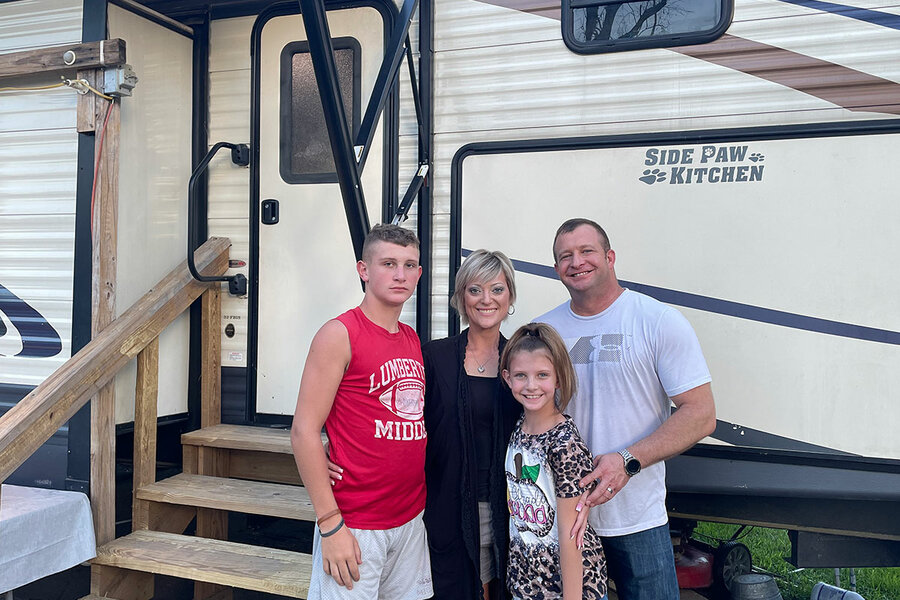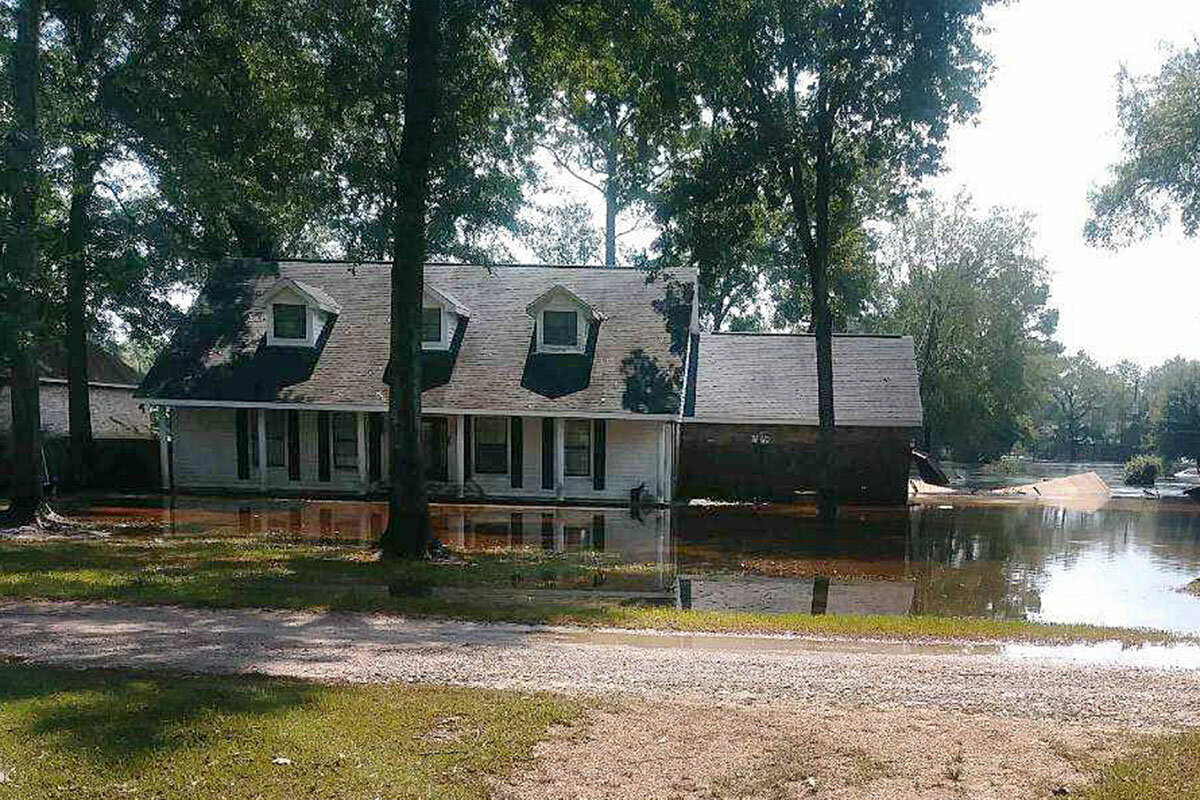Five years after Hurricane Harvey, a legacy of perseverance
Loading...
| Lumberton, Texas
The bayou’s waters behind their home in Lumberton, Texas, were rising higher than any neighbors could remember, faster than they ever had. It was late August 2017, and the Albritton family – Patrick, Krystal, and their two children – had only been living there three years.
Eventually, Ms. Albritton and a family friend made the decision to leave. Hurricane Harvey’s waters were flooding over nearby U.S. Highway 96; the family was running out of time. But before they left, she doubled back to clean their home’s kitchen. She figured they’d return in a few days. School was starting soon. The kids’ closets were ready; the tags were still on their new clothes.
They thought their home would be safe. It was located in an X flood zone, an area determined in federal guidelines to be outside the 500-year flood risk. For that reason, the Albritton family declined to acquire flood insurance.
Why We Wrote This
A story focused onLong after Hurricane Harvey inundated southeastern Texas, residents are still struggling to rebuild. But rather than losing hope, they are finding patience, resolve, and humor to carry them through.
It would be days until they could even return to their property. Seven feet of water inundated their four-bedroom home, nearly to the eaves of its roof. It was a total loss. Mr. Albritton, who had been away at work in Baton Rouge at the time of the storm’s flooding, remembers the jolt he felt in his stomach on the day they approached what remained of their soaked belongings.
Five years later, they still haven’t been able to rebuild. Additional large storms have threatened new floods. Yet, though struggling, the Albritton family exemplifies a common phenomenon here: Even in a region where a changing climate poses growing risks, and where people may lack important disaster insurance, residents aren’t fleeing in search of safer homesteads. Rather, through fortitude and perseverance, they are moving forward with their lives despite the added complexity that comes with unpredictable weather trends.
“It’s hard on us as adults,” Ms. Albritton says of how the family has coped in the years since Harvey, living a small travel trailer.
Mr. Albritton and his wife lean their shoulders into each other and grab hold of each other’s forearms. People “don’t know what our day to day consists of outside of what they see,” he says.
New era, new demands
That kitchen remains unwashed. Yet the Albrittons are still here, their children launching a new school year.
In fact, far from creating an outbound trail of “climate migrants,” Hurricane Harvey has been followed by a period of local grit coupled with continued population growth in this region.
That’s not surprising: This land isn’t permanently sinking under water, and to most in the area it’s their longtime home – both Patrick and Krystal Albritton grew up just 30 miles away. Yet their struggles hold lessons for the nation amid warnings by scientists that climate change is deepening challenges, from drought and wildfires to heavy rainstorms.
Affected cities like Houston are working to gird for the prospect of more storms of such magnitude. But a hard reality is that many people throughout southeast Texas and other rural regions have relatively low incomes, don’t have flood insurance, and live where local governments have limited resources to bolster their support.
“There’s a capacity inequity,” says Samuel Brody, a flood mitigation expert and the director of Texas A&M University’s Institute for a Disaster Resilient Texas. “Without the capacity to understand, to plan and to mitigate” for future flood risks, “small communities are going to continue to be left behind.”
The gap in urban and rural community equity has widened since Harvey, Dr. Brody adds, noting how metropolitan Houston has received the bulk of assistance. But even as rural localities around metropolitan areas get as much, if not more, rainfall, “they’re not getting the same attention.”
The Albritton family moved into a small travel trailer next to their home in the weeks after Harvey. They took out a $170,000 Small Business Administration loan to repair their home, which they now have to pay on top of their mortgage. They found a contractor. The contractor began the work. He never finished. Under Texas law, the Albrittons have little leverage.
The kitchen in their family home was symbolic to Ms. Albritton. It was the nexus between them, their relatives, and friends, and an extension of her love language as a host. To brighten holiday events for the kids they had costumes on hand – Mickey and Minnie Mouse, the Easter Bunny, Santa Claus.
Now the family of four leans on their sense of humor in their efforts to cope. In living quarters as small as theirs, it’s difficult to not lean on each other when meandering about, they say, laughing.
The Albrittons have also occasionally attended counseling.
“She put it in a very relatable way: ‘When you walk out the door, you get closure,’” Ms. Albritton says of their counselor. “But for us everyday, we don’t get that closure.”
How a region responds
The personal efforts of people like the Albrittons are paralleled by broader efforts to help this region cope, recover, and strengthen itself.
Flood mitigation researchers and governments – local, state, and federal – are working to understand how to future-proof regions like southeast Texas for Harvey-like natural disasters. In part due to the fact that another similar flood is likely to occur again, researchers say.
That storm was not just massive but unusual. On the Gulf Coast, Hurricane Harvey made three landfalls over the course of six days, starting on Aug. 25, 2017. Hovering over the region, it dumped between 24 trillion and 34 trillion gallons of rainfall across the Gulf Coast. In some places as much as 50 inches.
Beyond the sheer rainfall of the nation’s second-costliest storm (with $125 billion in damages, behind only Hurricane Katrina in 2005) “what was less of an anomaly was the way we have built upon and imprinted the landscape – putting people in harm’s way over time,” Dr. Brody says. “That exacerbated the impact.”
Now Texas is working to become a beacon of flood mitigation research and “one of the most resilient states in the country,” Dr. Brody says of his and others’ recent work.
But he also notes the lingering gap between urban and rural capacities to cope. It’s a fact Deanna Coburn and her family became acquainted with during Harvey’s flooding.
“I grew up in Lumberton,” Ms. Coburn says. “We’ve never seen anything like” Harvey.
During the storm, the Coburn family stayed, but their mobile home floated off its blocks. Their barn full of chickens, goats, and pigs flooded. Their herd was thinned as animals either drowned during the flooding or ingested polluted water in its aftermath.
“My husband grew up on this land,” says Ms. Coburn, whose family runs a farm a few miles outside of Lumberton. “Even in 1994,” a 100-year flood event that saw up to 28 inches of water in towns like Lumberton, “it never flooded here. And we all remember how bad 1994 was.”
Better warnings and preparation
After Harvey was followed by the deluges of Hurricane Imelda in 2019, a new effort to support the region arose. Lamar University initiated the “Southeast Texas Flood Coordination Study” linking local counties, state and federal agencies, researchers, and others in the hope of better understanding future flood threats.
As part of their collective effort, the parties joined forces to partake in a national test with the U.S. Department of Homeland Security in installing flood sensors throughout southeast Texas, from rivers and creeks to neighborhoods that often experience urban flooding.
Also born out of this teamwork: Lamar University established a Center for Resiliency last year to do research and public education to support disaster preparation and mitigation.
“We are a communications hub,” says Dr. Liv Haselbach, a civil and environmental engineering professor at Lamar and the director of the center. “We think we are a model for how a regional university or entities like us can become a hub that brings people together.”
In practice, they hope their work will better allow for evacuations in areas most at risk of floods. It would also better prepare important infrastructure, like local petroleum refineries, with information that would allow them to assess risk and potentially close levee gates earlier.
Importantly, though, their efforts are to help folks like the Albritton family.
Sitting next to each other in their small travel trailer, Ms. Albritton points to their children. Their son is 13 years old; their daughter, 9. The Albrittons feel as though they’ve been unable to give their children the lives they promised. That guilt has weighed on them personally – on their marriage, on their mental health, on their livelihoods.
Their family lost much in Harvey’s floodwaters. Their furniture, their children’s toys, clothes – that was one thing to lose. All of it was expendable. But the family heirlooms – the baby photos going back generations, the keepsakes from Mawmaw, more; it was all lost in the flood.
“I feel guilty for that. That’s something I’ll carry with me forever,” Ms. Albritton says. “Because I felt like I should have taken the flooding more seriously. I just didn’t think it was going to happen.”
“I thought material things mattered,” she adds. “But after I got home, no, it’s not what matters.”






